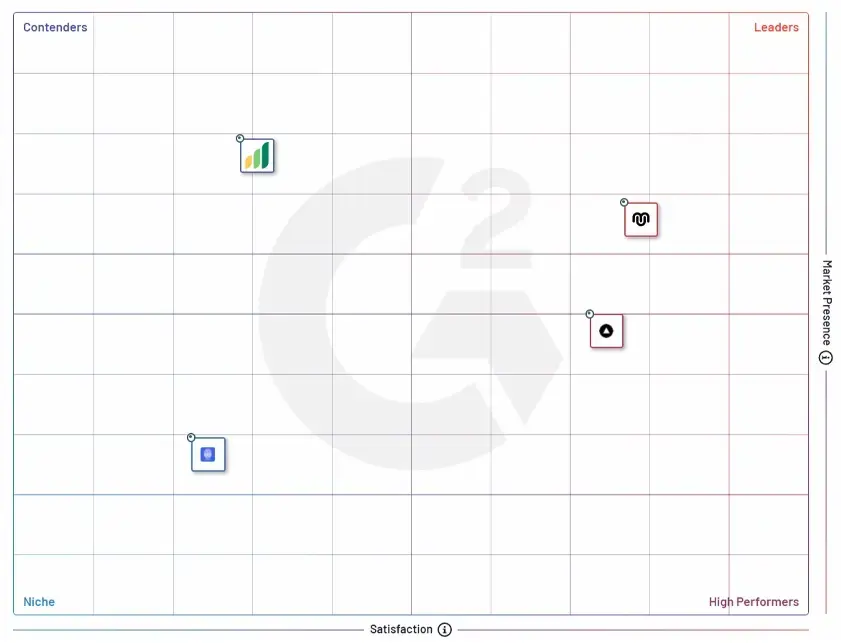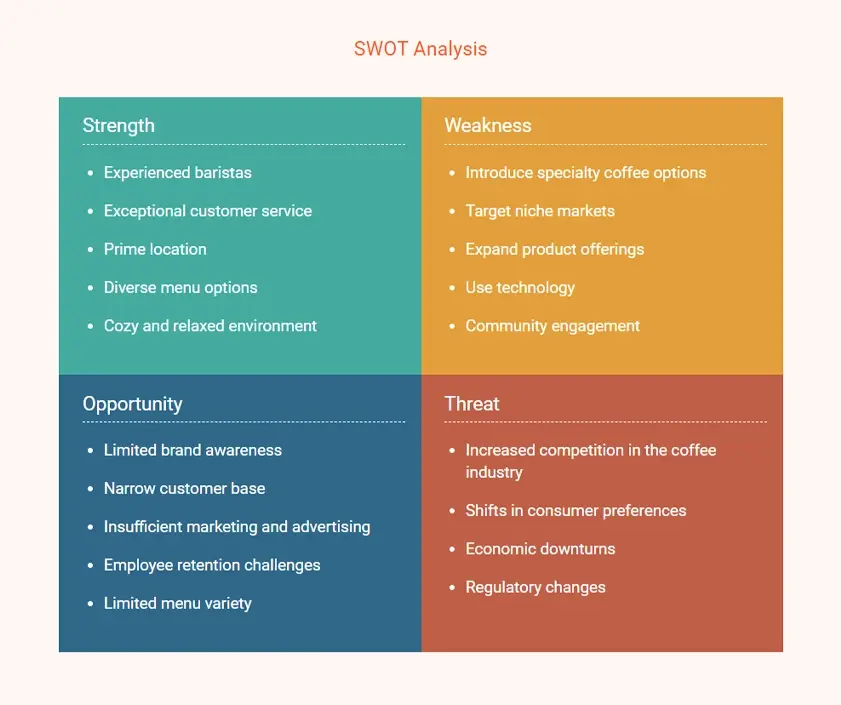Remember Nokia? They were the most popular phone company back in the day. Almost everyone had a Nokia phone. But then, smartphones came along. Companies like Samsung and Apple took over and Nokia was left behind.
Why? Because Nokia didn’t pay much attention to competitor analysis.
Contrary to what many people think, a competitor analysis doesn't just tell who your rivals are, it sheds light on how you fare against them and your actual value in the market.
It also gives insights into aspects like what your competitors are doing well, and where they're falling short. A real treasure trove of data.
If you're new to conducting a competitor analysis, you’re at the right place. We’ll go over a simple step-by-step guide you can use to know your competitors a lot more closely and prepare enough to outperform them.
But before we move on to that, let us start with some basics:
What is a competitive analysis?
A competitive analysis involves learning about your rivals. You find out what they're good at and where they fall short. Then use that knowledge to figure out how to make your own business better and stay ahead of the competition.
How to conduct a competitive analysis?
Competitive analysis goes beyond just finding your unique selling point. It's about understanding the competition in depth to figure out where you fit in, and how to make your mark.
With that being said, here’s how to carry out a competitive analysis:
1) List your competitors
Begin by listing down everyone in your industry.
Don't worry about being too selective at first—just note any business offering a similar product or service.
If you're local, you likely know your competitors. But for online businesses, it's trickier to identify your competitors. Start with basic keyword research on Google.
Search for your product category in a few different ways, adding words like "price," "cheap," or "sale" to focus on businesses actively selling. This helps identify competitors and see how crowded the target market is.
Once you've found your competitors, group them into categories like these:
Direct and indirect competitors
Direct competitors are your head-to-head rivals. They offer the same product or service to the same target audience as yours. Your potential customers will likely compare you directly to these companies when making a purchase decision. Cab services like Uber and Lyft are good examples of direct competitors.
On the other hand, indirect competitors address the same problem as you but typically offer a different solution. Although they may not have a direct impact on your business. But they can provide valuable insights into potential areas where you might expand or innovate. For example, gyms and home workout equipment companies can fall under this bucket.
Legacy competitors
These are big, well-known organizations that have been around for a long time. People trust them and often buy their products. Think of Coca-Cola—it's almost another word for a refreshing drink.
Emerging competitors
These competitors are like new kids on the block who might offer the same products and services as yours. They enter the market with innovative ideas or ways of doing things. These firms can grow really fast and sometimes even challenge the big players.
Organizations like Beyond Meat and Impossible Foods are good examples. They're changing the food industry with their plant-based meat alternatives and challenging traditional meat producers.
2) Analyze your competitors' position
After identifying your competitors, carry out a detailed analysis of their market position. This means checking things like total sales volume, organization size, turnover, and product range. By understanding all of this, you'll know where your competitors stand in the industry and how they affect the overall market landscape.
This analysis also lets you understand your own market share. It will give you clues about how customers perceive your brand compared to others.
Don't worry if the market seems crowded, visualizing the competition can still show you opportunities for your brand.
You can make a graph that puts competitors into categories based on two main things: market presence and customer satisfaction. This will help you see where each competitor fits, and that can reveal potential areas where your brand can grow.
Here’s how to go about the graph:
- Market Presence (Y-axis): Represents the overall market share of each competitor.
- Customer Satisfaction (X-axis): Indicates how customers perceive the quality and service of each brand.
After that, categorize your competitors into four distinct groups:
- Niche: Brands with a small market share but high customer satisfaction. They focus on a specific group of customers and do it well.
- Contenders: Brands with low customer satisfaction but a decent market share. Can be new companies with strong sales and marketing.
- Leaders: Brands with a large market share and very satisfied customers. They're dominant players with a great reputation.
- High performers: Newer brands with high customer satisfaction but a small market share. They're a good option for people who don't want to buy from the big brands.
This visualization will show you how competitive the market is. More importantly, it will highlight opportunities for your brand to grow and compete.
You can take inspiration from this market landscape grid by G2 documenting the position of top AI-powered business plan generators.
3) Create a comparison report
Now that you know your main competitors, it's time to analyze each in detail and create a comparison report. The motive here isn’t to find your competitors’ faults. It’s rather to sketch out all of their strengths and weaknesses and visualize how they compare against you.
Here are the key factors to consider when making a comparison report for your competitors:
- Look at the quality of their products or services. Compare features to see what they offer and what you don't. Also, check customer reviews to understand how people feel about their product or service offerings.
- Take note of each competitor's pricing. Try to understand their pricing strategy and talk to their customers to get their perspective on value for money.
- See how they provide support–do they offer chat, phone, email, or a knowledge base? Check customer reviews to see what people say about their service.
- How is each competitor perceived in the market? Pay attention to any negative feedback or criticisms. Monitor social media platforms like Reddit or X to get firsthand insights into customer sentiment.
- If possible, figure out your competitors’ financial performance. Look for data on aspects like revenue growth and profit margins.
As an example, look at how we created a comparison table for social media management tools:
| Metric | Hootsuite | Buffer | Sprout Social | Agora pulse |
|---|---|---|---|---|
| Quality | Pros: Comprehensive features, large user base, mixed reviews on ease of use. | Pros: User-friendly interface, focus on scheduling and publishing. | Pros: Robust features, strong analytics, positive reviews. | Pros: Intuitive interface, good for teams, positive reviews. |
| Cons: Steep learning curve, complex interface may overwhelm new users. | Cons: Limited analytics compared to competitors, lacks advanced features for larger teams. | Cons: High subscription costs, slower customer support response times, and limited international presence. | Cons: Higher cost, lacks some enterprise-level features, and limited integrations with certain platforms. | |
| Price | $99-$249 | $5-$100 | $249-$499 | $79-$199 |
| Customer Service | Multi-channel support (email, chat, phone), mixed reviews on response times. | Email and chat support, generally positive reviews. | Email and chat support, responsive. | Email and chat support. |
| Brand Reputation | Established player, wide recognition. | Known for ease of use, good for smaller teams. | Respected in the industry, trusted by agencies. | Growing reputation, good for agencies and SMBs. |
You can create a similar table for your own company.
Remember, this comparison will involve conducting both primary and secondary research.
Primary research is all about gathering first-hand data. You're either talking directly to customers or experiencing the product yourself. It's about getting the inside scoop and real-world insights.
Secondary market research involves tapping into existing data. You're analyzing data that's already been compiled by others. It's a smart way to gain a broader understanding without starting from scratch.
4) See how your competitors are promoting their products
Next, you'll analyze your competitors' marketing efforts instead of just their product offerings. This means digging deeper to understand their overall marketing strategy.
Look closely at things like their:
- Social media presence
- Website text
- Running paid ads (if any)
- Press releases
- Product descriptions
As you do this, ask yourself questions to understand their approach:
- What story are they telling?
- What value do they offer customers?
- What's their company mission?
- How would you describe their brand's voice?
5) Conduct a SWOT analysis
Finally, conduct a SWOT analysis. This is a great tool to spot opportunities you can use and threats you need to prepare for.
In short:
When looking into strengths and weaknesses, focus on your own company. What are your company’s core strengths? These might include a strong brand, a loyal customer base, or efficient processes.
On the other hand, where could your company improve? This could be customer service, product variety, or marketing strategies
For opportunities and threats, see the market and industry–what trends can you take advantage of, and what external factors might affect you?
When analyzing your competitors, take these factors, and use the following tools to collect information:
- Market share: How much of the market do they control? Tools like Statista or SimilarWeb can help track this.
- Special features: What makes their product or service stand out? Customer surveys and product comparison websites/tools can be helpful here.
- Company culture: What are their values and how do they treat their employees? Sites like Glassdoor offer insights into company culture.
- Customer reviews: What are people saying about their products and service? Check platforms like Google Reviews, Yelp, or Trustpilot
- Location (if relevant): Where are they located, and how does that affect their business? Google Trends can show you where a brand is popular.
While this analysis won't tell you exactly how to beat your competitors’ product offering or new ideas, it will give you a big-picture view of your situation. It’ll help you put together a solid competitive strategy.
How to write your competitive analysis in a business plan?
One of the most important parts of business plans is analyzing your competition. So before you go on to google ‘competitive analysis business plan,’ here’s a simple step-by-step guide to get you started ASAP:
Know who you're writing for
Are you explaining things to your team or trying to impress potential investors? This makes a big difference.
If it's for your team, the goal is to help them understand who else is out there and what they're doing well (and not so well). This will help everyone make smart decisions about your own strategy.
If you're writing for investors, let them know that your business can succeed even with competition.
Your focus here should be to highlight your knowledge about your target market, and identify opportunities of growth.
By tailoring your analysis to your audience, you'll ensure it's both effective and useful.
Highlight your competitive advantage
Remember those unique strengths you discovered during your research regarding your business?
Show them in your competitive analysis–maybe it's your unique approach, great product quality, special features, good prices, or fantastic marketing strategies.
Understanding your competitive edge also helps you clearly explain what you offer later in your business plan.
Also, don't forget to mention any other areas where you're better than your competition, even if it's amazing customer service or a really good reputation.
Tip: A picture is worth a thousand words. Try using charts or graphs to show how your organization compares to others.
Show your strategy
Competitor analysis should also show how you plan to tackle any problems that come your way. These strategies might include things like:
- Making your products or services the best they can be.
- Coming up with innovative products.
- Finding and targeting a specific group of customers that your competitors are yet to reach.
- Coming up with creative marketing ideas.
You can elaborate on these strategies in more detail in other sections of your business plan.
Know the pricing strategy
To effectively evaluate your competitors' pricing strategies, start by researching key elements of their approach. This includes:
- Understanding their pricing model: Check whether they're using a cost-plus model, value-based pricing, or anything else.
- Analyzing their price points: What are the actual prices for their products or services?
- Considering any additional costs: Are there hidden fees, shipping costs, or premium options that impact the final price?
One effective way to assess this is by comparing the features and value they offer at various price points. This analysis can highlight areas where competitors might be lacking or where they provide more value.
After understanding their pricing structure in detail, compare it with your own. It helps you identify where your pricing strategy gives you a competitive advantage.
When presenting your pricing strategy in a plan:
- Be clear about how it stands against the competition.
- Highlight where you offer better value.
- Explain any premium pricing by tying it to enhanced product features or customer benefits
Now, let's get more practical and look at a real-world example of competitive analysis.
Practical examples of competitive analysis
List of Competitors
Direct and Indirect Competitors
The following coffee shops are located within a 5-mile radius of Brew House, providing either direct or indirect competition for customers:
Morning Mug Café
Morning Mug Café has been in business for 32 years and is the town's most popular cafe. They have a wide range of beverages.
Besides offering coffee, Morning Mug serves pastries and sandwiches. In fact, over 60% of Morning Mug’s revenue comes from food items outside of coffee. However, Morning Mug doesn’t offer its customers premium coffee beans.
For example, they only offer 2 types of regular coffee blends and 4 types of flavored syrups. This puts Morning Mug in direct competition with the local convenience stores and supermarkets that also carry these mainstream products.
Brew House, on the other hand, offers numerous options for exclusive coffee blends that are not yet available in West Palm Beach, Florida.
Elite Brews
Elite Brews has been in business for 5 years. Elite Brews offers an extremely high-end coffee experience, with introductory prices of $15 per cup.
However, Elite Brews primarily targets a different customer segment from Brew House, focusing on households with an income in the top 10% of the city.
Furthermore, Brew House offers many of the services and products that Elite Brews offers, but at a fraction of the price, such as:
- Barista-led coffee brewing classes & personalized coffee recommendations
- Gourmet pastries & desserts
- Premium coffee beans from renowned global suppliers
Quick Sip Café
Quick Sip Café is located four stores down the road from Brew House. Quick Sip has been in business for the past 3 years and enjoys great success, primarily due to its prime location.
Quick Sip offers inexpensive coffee and focuses on volume over quality. It also has a large customer base of students and office workers looking for a quick caffeine fix.
Brew House has several advantages over Quick Sip Café including:
A cozy lounge area, with books and magazines to enhance the coffee-drinking experience. Perfect for customers who want to relax or work while enjoying their coffee.
A focus on coffee quality rather than speed alone to ensure repeat visits. Brew House will spend on average 5 more minutes on each cup than Quick Sip.
While we expect that Quick Sip Café will continue to thrive based on its location and customer convenience, we anticipate that more and more customers will frequent Brew House based on the high-quality experience it provides.
Competitive Pricing
Brew House will work towards ensuring that all our offerings are priced competitively compared to what is available across other coffee shops in the United States.
We know it's important to start with lower prices to get more customers. We've talked to experts to figure out how to do this and grow quickly.
Our prices will be based on what other coffee shops charge. We won't be much more expensive (except for special items) or much cheaper than our competitors in West Palm Beach.
| Type of Beverages/Services | Morning Mug | Elite Brews | Quick Sip |
|---|---|---|---|
| Regular Coffee | $2.50 - $3.00 | $4.50 - $5.00 | $2.00 - $2.50 |
| Latte | $4.00 - $5.00 | $6.00 - $7.00 | $3.50 - $4.00 |
| Cappuccino | $3.50 - $4.00 | $6.00 - $6.50 | $3.00 - $3.50 |
| Espresso | $2.50 - $3.00 | $5.00 - $6.00 | $2.00 - $2.50 |
| Pastries | $3.00 - $3.50 | $5.00 - $6.00 | $2.50 - $3.00 |
Our Pricing
At Brew House, we want to give you great coffee and treats at prices that are fair. We care about quality, but we also want everyone to be able to enjoy our coffee.
| Beverage/Service | Price Range |
|---|---|
| Regular Coffee | $2.50 - $3.00 |
| Latte | $4.00 - $5.00 |
| Cappuccino | $3.50 - $4.00 |
| Espresso | $2.50 - $3.00 |
| Pastries | $3.00 - $3.50 |
Payment Options
We know it's important to have different ways to pay. We want to make it easy for you, no matter which Brew House you visit. Here's how you can pay:
- Cash
- Point of Sale (POS) Machine
- Online Bank Transfer (through our website or app)
- Mobile Payment Services (e.g., Apple Pay, Google Pay)
- Check (available for loyal customers)
Competitive Advantage
Location
Brew House is right in the middle of town. This makes it easy to find for people going to the train station, working nearby, or just shopping. We also have plenty of parking, so you can stop by without any hassle.
Good Prices
We’ve all the famous coffees and pastries you'd find at a place like Elite Brews, but our prices are way better. You get the good stuff without spending a ton of money.
Expert Team
Our managers know what they're doing. They’ve lots of experience in business and marketing, so they'll ensure Brew House is successful. We'll reach more people and do it in a smarter way than other coffee shops.
Local Connections
Jane Doe, who started Brew House, has lived here for over 25 years. She knows everyone important in town. That means people will hear about us quickly, and we'll build a strong group of regular customers.
SWOT Analysis
Tools and resources for competitive analysis
Many tools can help you in checking your competitors.
For example, social media management platforms like Sprinklr allow you to monitor your competitors' activity.
You can see things like:
- What they're posting.
- How their audience engages with their content.
- What people are saying about them across the web.
If you want to research deeper, tools like Phlanx and SocialBlade can help. They show you how much your competitors’ followers interact with their content and whether their follower count is growing or shrinking.
Then there are SEO tools like SEMrush and Ahrefs.
These tools help you figure out:
- What keywords your competitors are targeting
- How much traffic they're getting from those keywords
- Which pieces of their content are doing really well
And if you’re wondering what type of content your competitors are creating and how well it’s performing, content analysis tools like BuzzSumo and SimilarWeb can be very useful. They’ll help to focus on the topics driving your industry and the types of content most shared.
If all that seems like a lot of data to sort through, AI-powered tools like Kompyte and Crayon can take over. They automatically track all changes that are taking place on your competitors' websites and social media.
It helps you to get real-time competitor insights. For example, with these tools, you can track your competitor's product launches, pricing changes, and marketing campaigns. This way you can refine your own strategies, identify competitive advantages, and make data-driven decisions.
Not to forget email and ads. Tools like Mailcharts and Owletter let you view what your competitor is doing in terms of email marketing—what they say, how often they send emails, and how their campaigns perform.
Conclusion
Knowing what your competitors are good at (and where they lack) makes you a smarter marketer. After all, you can't beat them if you don't know who you're up against, right?
Competitive analysis gives your marketing strategy a real boost. Helps you connect with your target customers faster.
But analysis is just the first step. You need to take action on what you learn. That means setting clear business goals and creating a solid business plan based on your findings—to watch your ideas and dreams come to life.
Get Your Business Plan Ready In Minutes
Answer a few questions, and AI will generate a detailed business plan.
Frequently Asked Questions
What are the 5 parts of a competitive analysis?
The 5 parts are:
- Identifying your competitors
- Analyzing their strengths and weaknesses
- Understanding their market strategies
- Evaluating their products or services
- Assessing their financial performance
What is the purpose of a competitive analysis in a business plan?
The purpose of a competitive analysis is to identify your competitors, understand their strategies, and learn how you can differentiate your business to gain a competitive edge.
What is the difference between market analysis and competitive analysis?
Market analysis looks at the entire market, including size, trends, and customer needs. Competitive analysis focuses specifically on your competitors and how you stack up against them.
Can competitive analysis help in identifying market opportunities?
Yes, by analyzing your competitors' strengths and weaknesses, you can identify gaps in the market that your business can fill.
Do I need to include every competitor in my analysis?
No, focus on your main competitors, the ones most similar to your business and have a significant market share. This will help you get a clear picture of your competitive landscape without getting overwhelmed.







